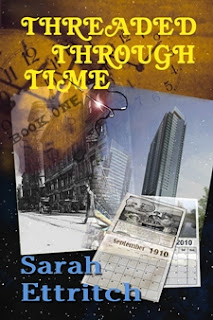Guest Blog Today: SARAH ETTRITCH
Print or eBook? Why Print is No Longer the Default Choice
In early 2010, Rymellan 1: Disobedience Means Death, the first book I published through my publishing company, Norn Publishing, hit the online bookstores. Going to print was a no-brainer. The eBook was an afterthought.
Then the eBook revolution took publishing by storm, and the dust hasn’t settled yet.
When it came time to publish my latest book, I had a decision to make: print, eBook, or both? A mere sixteen months earlier, print would have been a given.
I decided to make Threaded Through Time, Book One available as an eBook only. Why? Like many self-publishers, I sell way more eBooks than print books. To illustrate, I tallied up my sales numbers for 2011 (through July), and my sales breakdown was 90% eBook, 10% print. Since Threaded Through Time, Book One is only available in eBook, I didn’t include it in my calculations. The breakdown applies to my three books that are available in both formats.
When faced with a data like that, it’s difficult to justify the extra time and expense required to take a story to print. Editing is always a given, so let’s move that aside and examine the areas where print and eBook differ: cover design, formatting, and setup fees.
Cover Design
An eBook cover is a simple JPG file. I can hear cover designers screaming that it’s not that simple to design one, but I mean simple to produce relative to print covers. :)
Print covers are more complicated. Printers require what’s called a print-ready PDF file, and each printer has unique specifications, some of them quite technical. In addition, the cover designer has to design the front cover, back cover, and spine. As you can guess, this means that print covers are more expensive than eBook covers.
If you’re publishing in both print and eBook, the eBook cover cost is absorbed by the print cover cost, since the eBook cover is just a JPG of the print front cover. But you’ll pay more for that print cover than you would have paid for only an eBook cover.
Formatting
Formatting an eBook means taking a Word file and converting it to formats that can be read by Kindles, nooks, kobo readers, etc. You can do it yourself, or you can pay a formatter to do it for you, usually for less than $100.00.
Print books have to be typeset. This is usually expensive, and will definitely cost you more than $100.00. If you do it yourself, you’ll have to teach yourself how to typeset, and you’ll probably have to buy pricey typesetting software to get a professional look.
Setup Fees
Most eBook venues don’t charge you to upload a book. If you use Amazon KDP and an aggregator like Smashwords, you can upload your eBooks to all the major venues for free.
When it comes to print, you’re looking at setup fees. CreateSpace, Amazon’s print-on-demand service, only charges to send a proof copy to your home (a test print of your book, so you can see what it looks like and correct any problems before you release it into the wild). When you sell a book on Amazon, CreateSpace takes 40% of the list price. If you put your book into CreateSpace’s extended distribution channel and sell a book through one of its extended partners, CreateSpace will take a hefty 60% of each sale.
Lightning Source, another popular print-on-demand printer, charges a $75 setup fee, $30 for your proof, and a $12/title/year catalog fee. But you can set things up so that you only give up 20% of each sale, no matter where you sell your book. You pay more up front than you would with CreateSpace, but you also keep more money on each copy sold. Over time, you’ll earn more by going through Lightning Source.
The setup costs will vary depending on the printer. Since there are reasonable ways to get your eBooks into all the major venues for free, setup costs are an extra expense for print books that eBooks don’t have.
Do it All For Free
Sure, you can do the cover and formatting yourself and pay $0. However, not all of us are talented cover designers or know how to typeset. If you want your print book to look as professional as those released by traditional publishers, you probably don’t want to do it all yourself.
My Books
Let’s get back to my decision. I don’t do my own covers. I used a talented designer named Patty Henderson—perhaps you’ve heard of her! Patty charges more for a print cover than she does for an eBook cover, as all designers do. Formatting is a wash for me, because I format my own eBooks and typeset my print books. I use Lightning Source for printing, so that’s $75 + $30 + $12 = $117 extra for print.
Overall, taking a book to print costs me several hundred dollars above and beyond what I’ve already paid to take it to eBook. As I said earlier, it’s difficult to justify that cost, given the number of print books I typically sell and how long it will take me to earn back those several hundred dollars. Going to print would put me hundreds of dollars in the red before I get started, and that’s in addition to the editing dollars I’ve spent. But while editing is essential, taking a book to print is no longer required to sell a decent number of books.
On the Fence
Having said all that, I still haven’t decided whether to take Threaded Through Time, Book One to print. As the title implies, Book One is the first book in a series (of two). If I do take the story to print, I’ll do it by releasing Books One and Two in a single print volume. I’ll pay the cover design costs and setup fees once, rather than twice.
So...
Conventional wisdom says to offer your book in as many formats as possible, but if your data tells you that not many are buying print, then releasing a title as an eBook only can make more sense.
Publishing only eBooks isn’t new. Some publishers have always been eBook only publishers, and new digital publishers are springing up all the time. Others initially release to eBook and take only those that sell well to print.
If you’re wondering what you should do, think about how many print books you expect to sell vs. how much it will cost you to produce a print version. If going to print will significantly multiply the number of books you’ll have to sell to break even, it might not be worth it.
Keep in mind that not going to print isn’t an irreversible decision. If your eBook sells well and you’re confident that you’ll make back your extra print costs, go for it. Or perhaps you’re in it for the long haul and won’t mind if it takes 20 years to recoup your costs. That’s okay too. When it comes to self-publishing, it’s whatever works for you.
About Me
To learn more about me and my books, visit http://www.sarahettritch.com.
Thanks for hosting me today, Patty.



Comments
L.M. Townsend-Crow
Having said that, when it comes to making decisions about how to publish my books, I have to put my personal preferences aside and do what makes sense for the business.
That does not make this transitional period any easier for the reader, but change from print to ecopy is inevitable.
Thanks for buying and reading my books! :)
I'm just finishing up the typesetting for the print version now, which will have to be uploaded to the printer, then the proof will need to be checked before it can go live. And all the while the ebook is out there racking up sales.